Focus: GS-III Industry and Infrastructure, Prelims
Why in news?
Oil and Natural Gas Corporation Ltd (ONGC) has tested the first deep-water well at its largest block in the Krishna Godavari basin.
India’s Current stand on Clean Energy
- India’s emerging green economy is reordering the country’s energy mix to meet its global climate change commitments.
- These sources include a combination of solar, wind, ultra-supercritical coal fuelled projects, gas based plants and nuclear power projects.
- India is running what will become the world’s largest clean energy programme with the aim of achieving 175 gigawatts (GW) of clean energy capacity by 2022.
- Given the country’s ambitious green energy programme based on infirm sources such as wind and solar, its gas-based power generation capacity can be leveraged for providing grid stability and be the intermediary fuel for India’s energy transition.
- India, the world’s fourth-largest importer of liquefied natural gas (LNG), is expanding its portfolio with domestic companies having inked long-term LNG contracts
Krishna-Godavari Block
- Krishna Godavari Basin is a peri-cratonic passive margin basin in India.
- It is spread across more than 50,000 square kilometres in the Krishna River and Godavari River basins in Andhra Pradesh.

- Krishna-Godavari inland and offshore basins have good prospects of tight oil and tight gas reserves from the conducted field studies.
- Most of the conventional wells drilled and operated have a shorter lifespan than envisaged life and with erratic production.
- This may be due to drilling of conventional wells in tight oil and gas fields without horizontal drilling in the shale rock formations and hydraulic fracturing.




